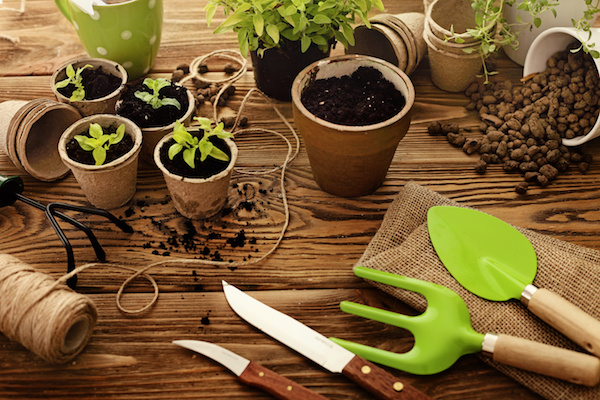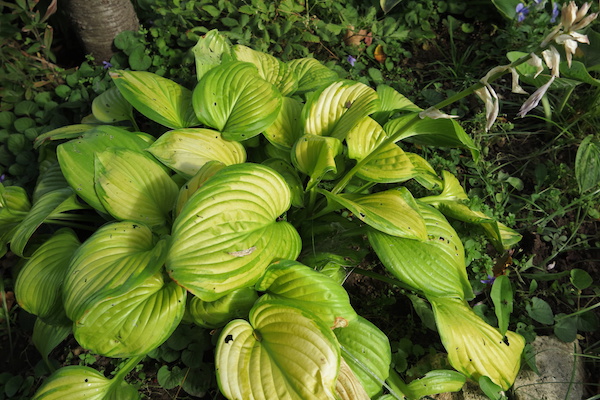
by Edythe Falconer
Winter is still upon us, but we have turned the corner into a new year and spring will be here in a blink. That being said, now is a good time to think about the upcoming gardening season. My mission is to give you a few fun and interesting design ideas for those forgotten or hidden garden spaces. My hope is that perhaps one of these small projects will help solve a problem area in your outdoor oasis.
Why small projects?
Last summer I was able to concentrate on the little details. This opportunity came after several years of disappointment with “big picture” items – trees and hedges had to be removed, fences replaced, and a rotting retaining wall repaired. These were all big projects that involved moving plants back and forth into holding beds and hiring people to do the work. I was ready for some small and manageable design challenges that would give me a bit of instant gratification.
Make corners count
Corners are difficult to reach with the lawn mower and can be an eyesore. A side project, which made use of surplus material from a landscape makeover in my front yard, fixed a difficult corner very simply at no cost. The surplus pebbles from the main project and a medium stone set vertically to prevent a groundhog from sheltering under a wooden walk- way made my corner problem a thing of the past. I added an attractive pot planted with annuals. For me, this simple fix reemphasized the importance and delight of little things; those subtle touches of minimalist design, tiny bits of inspiration and surprise.
Themes and variations
Some well-chosen perennials or annuals change a dull or vacant corner into something special. The same plantings repeated at adjacent corners create a theme. Themes and colour combinations can be maintained permanently or changed on an annual basis. A favourite semi-shade combo of mine is a variegated hosta paired with tall yellow irises. The contrasting shape and texture of the foliage is visually appealing. Statuary, wooden structures and ornamental pots are also good for corners and can be mobile with the help of a sturdy garden dolly or an athletic spouse. Found or repurposed items make interesting additions to your design, so keep an eye open for street-side treasures during evening strolls and/or check out yard sales.

Use orphan space
For the frequently orphaned space under deciduous and coniferous trees, there are several attractive possibilities – some more expensive than others. In my garden, I plan to have two overgrown apple trees professionally pruned and the chips spread beneath a weeping spruce in our front yard. I will edge this circle using a manual edger to a depth of 10 to 12 centimetres (four to five inches). This classical edge is now my favoured solution for border and freestanding beds. Dry-laid fieldstone (cracks left un-cemented to let water penetrate the surface under the tree) can add more interest, but is more labour and cost intensive.
Plant spring ephemerals – perhaps Mertensia (Virginia blue bells) – under deciduous trees. Other longer blooming choices are Pulmonaria (lungwort) or Heuchera (coral bells). Pulmonaria are attractive spring bloomers much beloved by hummingbirds and bees. With two or more cultivars, create a textured ground cover of different shades of green with varied greyish polka dots that add interest all summer long. Heuchera cultivars now sport a range of foliage colours that are even more exciting.
Go vertical
Not enough space to grow veggies? The quick fix is to go vertical. Trees, though not your usual trees, can include bean trees, squash trees, tomato trees and cucumber trees. The gardener must supply suitable support for each tree.
Bean trees are easiest, requiring only three or four stout 2.5- to three-metre (eight- to 10-foot) poles firmly anchored in the ground and secured at the top with wire or rope. Plant the climbing bean seeds around the base of the poles. Once they start producing, they don’t stop until the first hard frost, at which time any beans that haven’t been collected fresh can be dried and used for soups or baked beans in winter. Some can be saved for planting next year’s crop.
A squash tree takes more engineering as the produce is considerably heavier. Although it became obvious to me that sturdier, taller supports will be needed this year, I’m still very pleased with the results of my squash tree experiment last summer. Vines did not roam indiscriminately and fruits did not touch the ground. Butternuts store well and I harvested enough to last the winter, providing delicious pies and tasty squash soups. Squash is in the same family as pumpkin and can be used as a substitute.
Some tomato plants have an indeterminate growth habit – they simply will not stop growing. This growth habit makes them the perfect candidate for tomato trees. At some point, they need to be reined in with a bit of judicious pruning and will require sturdy support that is tall and wide. At my previous residence, I could tie tomato plants to my fences. Creative supports, purchased or homemade, are important structural components of garden art.
Use rock mulch in pots
This time-saving and plant-saving design tip will keep your planters healthy and happy. Our property is shared with many squirrels. I’ve learned that applying a layer of small rocks on top of the soil in my containers prevent squirrels from digging and frequently uprooting plants. The rock mulch also helps retain moisture and stifle weeds. With their amazing striations and shapes, rocks are an attractive addition.
Get creative with composters
Composters often end up hidden in a corner. However, composting on-site can be achieved without sacrificing artistic values. Consider using a large pot, a trench, or a hugel (hügelkultur replicates the natural process of decomposition that occurs on forest floors). Containers can be works of art, whether commercially obtained or home-built. Our gardens are actually mini-ecosystems and regular composting will keep our “systems” healthy at a very low cost. Healthy soil will extend the lifespan of our carefully chosen plants and our carefully planned landscapes.
Hopefully my rambling assembly of ideas has provided inspiration and new methods to add to your garden repertoire. If so, mission accomplished.
Edythe Falconer is a retired educator who gardened a large country property for several years. She re- turned to the city a few years ago and has been renovating and renewing that landscape since. She volunteers with the Master Gardeners of Ottawa-Carleton.






